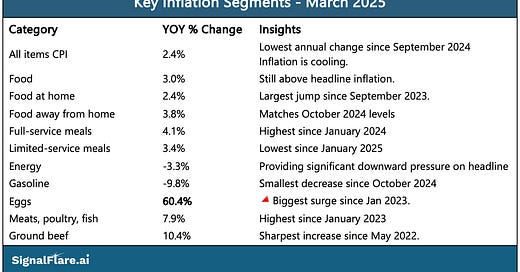Restaurant Prices Hold Steady as Broader Inflation Moderates
Restaurant CPI held at 3.8% in March (unchanged from February), with Full-Service restaurants maintaining their elevated rate at 4.1%. This continues the trend we first observed last month where Full-Service Restaurants are outpacing Limited Service in inflation rates (3.4%). The restaurant industry's inflation remains stubbornly at the October 2024 levels despite some broader economic moderation.
The headline CPI showed meaningful deceleration to 2.4% in March (down from 2.8% in February), providing a glimmer of hope in the broader economic picture. However, the ongoing divergence between restaurant inflation and overall inflation suggests structural challenges persist in our industry. Broader economic influences are also likely to upset current CPI moderation trend.
Energy Deflation Masking Food Pressures
While headline inflation appears to be improving, this is largely driven by a 3.3% decline in energy prices. Food inflation continues to run hotter at 3.0%, with food away from home holding at 3.8%. Within the grocery sector, a concerning trend emerges with a staggering 60.4% increase in egg prices year-over-year, the largest since January 2023. Meat prices are also showing troubling acceleration at 7.9% overall, with ground beef up 10.4%.
These rising input costs create a challenging environment for restaurants, putting pressure on margins and potentially leading to further price increases —at the risk of softening consumer demand.
Consumer Sentiment Remains Fragile
The divergence between improving headline inflation and worsening food inflation creates a mixed message for consumers. While gas prices provide some relief, the persistent inflation in daily necessities like food continues to erode purchasing power and sentiment.
The previously noted plunge in consumer expectations for the overall economy remains a significant concern. With spending patterns showing signs of fragility, restaurants face an increasingly complex pricing environment.
Business Implications
For the restaurant industry, these trends suggest continued pressure on both costs and consumer spending. The persistent outperformance of full-service restaurant inflation indicates:
Premium dining may retain pricing power, even amid ongoing economic pressures.
Labor costs remain a significant burden for full-service restaurants, disproportionately impacting operations.
Supply chain disruptions continue to drive up food costs, with much of the burden passed on to consumers.
The widening gap between limited-service and full-service inflation suggests emerging market segmentation—price-sensitive consumers may be trading down to limited-service options or shifting spending toward groceries, while higher-income diners maintain more stable spending patterns, though signs of softening are beginning to show.
Looking Forward
Businesses should remain cautious but strategic in their pricing approach. The moderation in headline inflation provides some hope that broader economic pressures may ease, but the persistent elevation in food costs suggests challenges specific to our industry will continue.
The combination of high food inflation and fragile consumer sentiment creates an environment where pricing strategy becomes increasingly critical. Restaurants must carefully balance the need to protect margins against the risk of accelerating volume erosion in a potentially softening demand environment.





